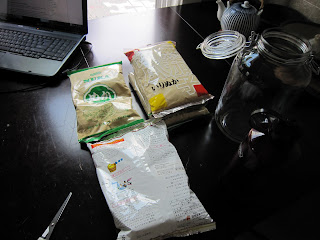



So fermented pickles (with rice) have been ~the~ basic low-rent staple as long as there have been poor people in Japan, and it's a pretty accurate example of what I ate most of the time when we ate home cooked food in Sasayama. Fermented food in general is considered to be very healthy, and fermented pickles are just good anyway. I'm not sure how they're made around here, but at Tsuji we had a pickle pot for making this particular kind (called nukazuke) which I never really got involved with, but should have. I was a little late on the uptake, and now of course, am itching to make my own. The vegetables are buried in a damp mixture of rice bran, salt, 'good' bacteria that comes from hand-stirring, and random things for flavor/sanitary reasons. Just for a day or two, though- the process goes fast. Chiles ward off the bugs, and daily stirring keeps it fresh. People keep their nuka going for years, decades, even longer - like sourdough cultures passed down through generations. You can start your own from scratch, though, if you have no one to give you a cup from their pot, and that's what I'm going to do.
I bought a huge glass mason-type jar with a rubber gasket and have four bags of rice bran that I found at a Japanese shop in Medford. I tried about 5 other places with no luck before I finally went out there. (Medford has always been like a psychological no-man's land to me so it was a stretch). I heard in Japan you can get it for free from places that mill rice and remove the bran. So anyway, now that i have it, I need to wet and salt it, add things like mushed bread or beer to get the fermentation going, chiles, crushed eggshells, garlic, and kombu (seaweed), and put in some starter vegetables that need to be replaced frequently. I looked this process up on several websites and there is a little variation in the advice that different people have posted, but this is all pretty much standard. Some people put in ginger slices, others put in fish flakes- the possibilities are almost endless. I am going to keep it pretty basic, at least in the beginning. Once the pot gets going, vegetables only need to be buried in the nuka for a couple of hours to a couple of days, depending on how thin or delicate they are. These are actually highly perishable pickles, not at all like the ones we're used to eating, so only really firm veggies like large chunks of daikon radish can handle being pickled for more than a couple few days. This is going to be interesting - we only pickled a few things at the farm, and we weren't incredibly vigilant about it despite the need for daily turning over (I think it was at least a week and a half before I even learned of the pot's existence) but if I can make it work it will be, well, pretty cool.
People who are serious about their nukazuke will actually travel with their pots, to make sure that the daily mixing is not interrupted. Considering that the cultured nuka improves over time and can be kept like a living family heirloom, that isn't actually so hard to understand.
Photos coming in an edit.







